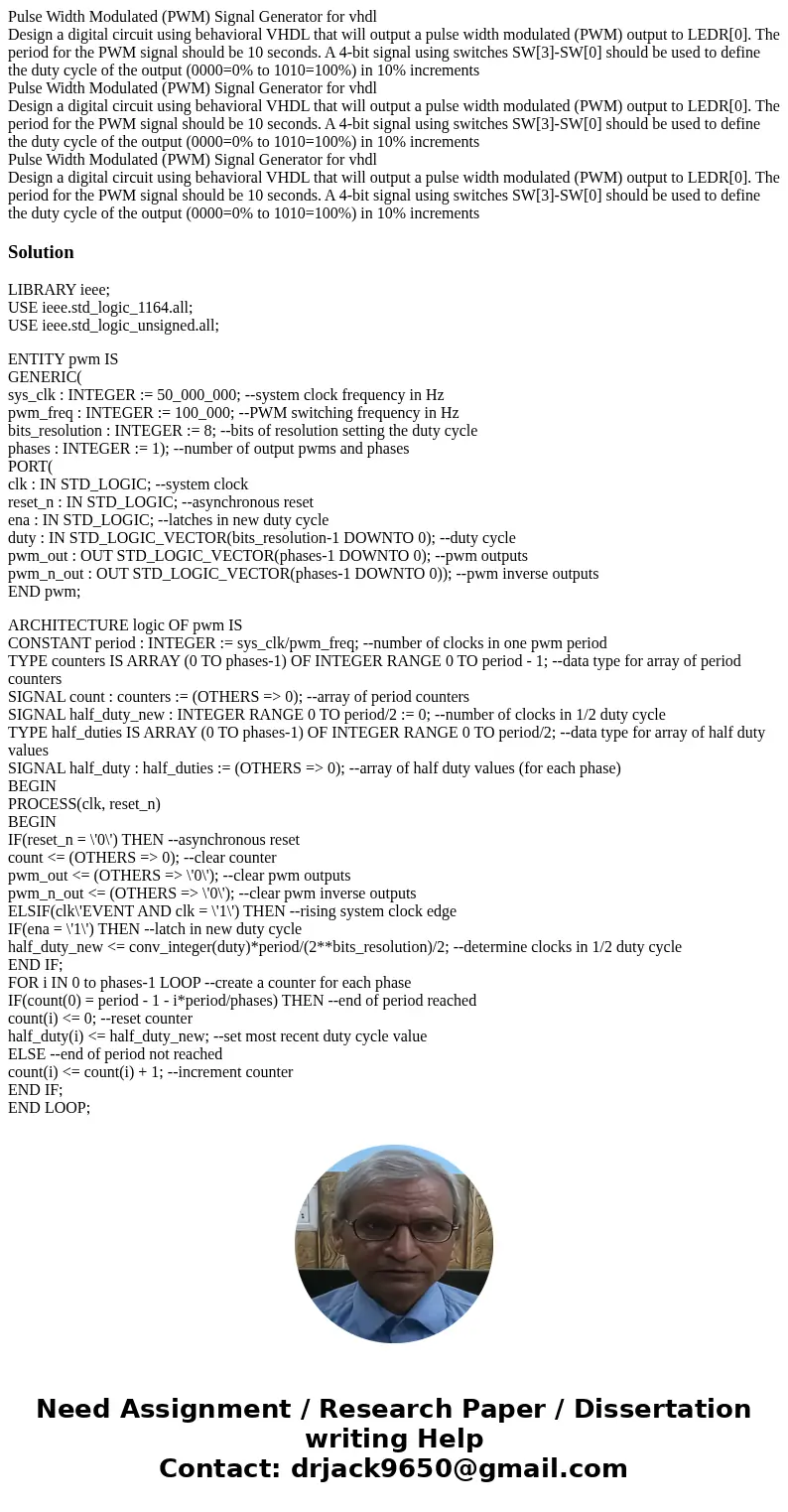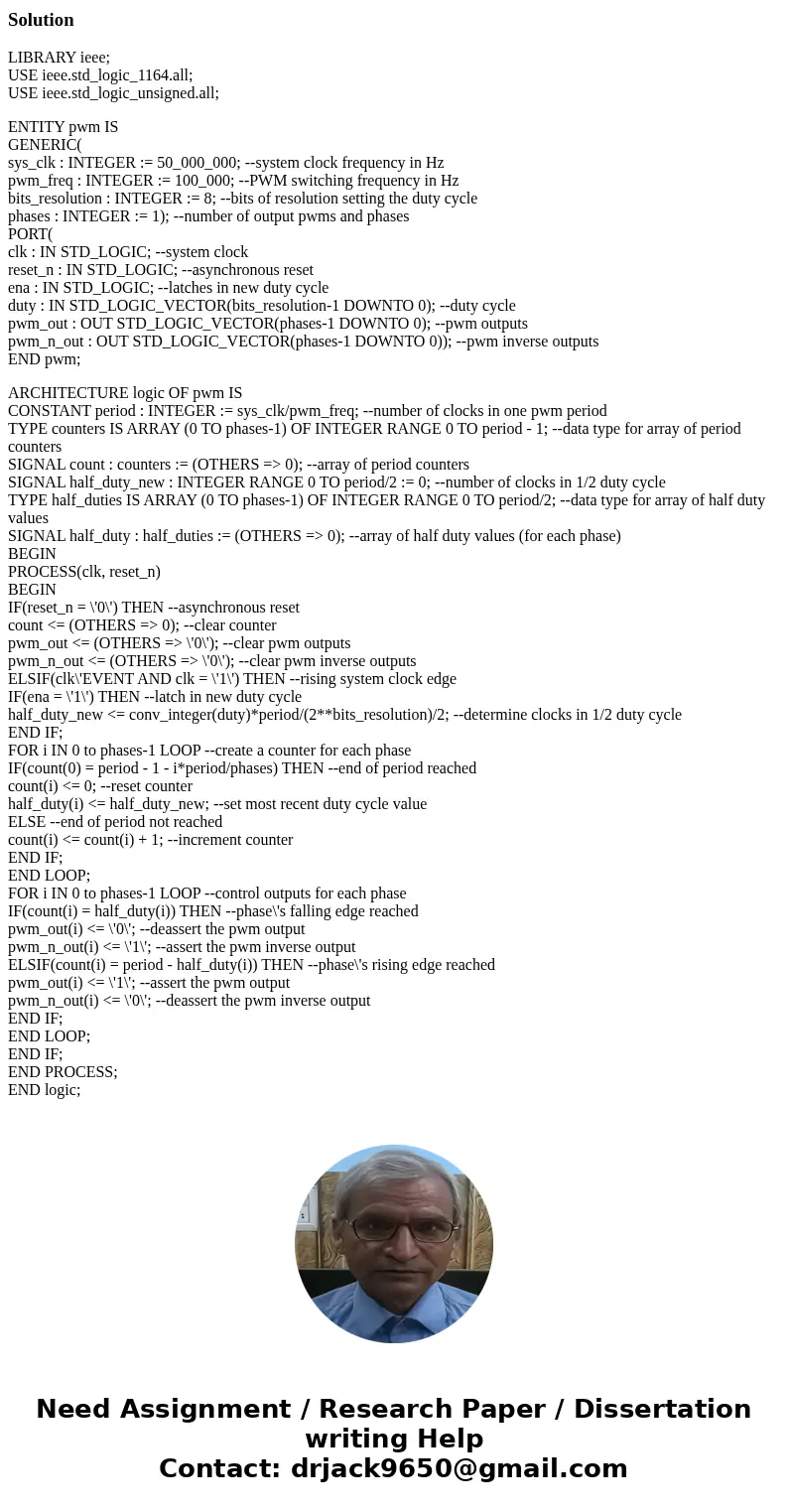Pulse Width Modulated PWM Signal Generator for vhdl Design a
Solution
LIBRARY ieee;
USE ieee.std_logic_1164.all;
USE ieee.std_logic_unsigned.all;
ENTITY pwm IS
GENERIC(
sys_clk : INTEGER := 50_000_000; --system clock frequency in Hz
pwm_freq : INTEGER := 100_000; --PWM switching frequency in Hz
bits_resolution : INTEGER := 8; --bits of resolution setting the duty cycle
phases : INTEGER := 1); --number of output pwms and phases
PORT(
clk : IN STD_LOGIC; --system clock
reset_n : IN STD_LOGIC; --asynchronous reset
ena : IN STD_LOGIC; --latches in new duty cycle
duty : IN STD_LOGIC_VECTOR(bits_resolution-1 DOWNTO 0); --duty cycle
pwm_out : OUT STD_LOGIC_VECTOR(phases-1 DOWNTO 0); --pwm outputs
pwm_n_out : OUT STD_LOGIC_VECTOR(phases-1 DOWNTO 0)); --pwm inverse outputs
END pwm;
ARCHITECTURE logic OF pwm IS
CONSTANT period : INTEGER := sys_clk/pwm_freq; --number of clocks in one pwm period
TYPE counters IS ARRAY (0 TO phases-1) OF INTEGER RANGE 0 TO period - 1; --data type for array of period counters
SIGNAL count : counters := (OTHERS => 0); --array of period counters
SIGNAL half_duty_new : INTEGER RANGE 0 TO period/2 := 0; --number of clocks in 1/2 duty cycle
TYPE half_duties IS ARRAY (0 TO phases-1) OF INTEGER RANGE 0 TO period/2; --data type for array of half duty values
SIGNAL half_duty : half_duties := (OTHERS => 0); --array of half duty values (for each phase)
BEGIN
PROCESS(clk, reset_n)
BEGIN
IF(reset_n = \'0\') THEN --asynchronous reset
count <= (OTHERS => 0); --clear counter
pwm_out <= (OTHERS => \'0\'); --clear pwm outputs
pwm_n_out <= (OTHERS => \'0\'); --clear pwm inverse outputs
ELSIF(clk\'EVENT AND clk = \'1\') THEN --rising system clock edge
IF(ena = \'1\') THEN --latch in new duty cycle
half_duty_new <= conv_integer(duty)*period/(2**bits_resolution)/2; --determine clocks in 1/2 duty cycle
END IF;
FOR i IN 0 to phases-1 LOOP --create a counter for each phase
IF(count(0) = period - 1 - i*period/phases) THEN --end of period reached
count(i) <= 0; --reset counter
half_duty(i) <= half_duty_new; --set most recent duty cycle value
ELSE --end of period not reached
count(i) <= count(i) + 1; --increment counter
END IF;
END LOOP;
FOR i IN 0 to phases-1 LOOP --control outputs for each phase
IF(count(i) = half_duty(i)) THEN --phase\'s falling edge reached
pwm_out(i) <= \'0\'; --deassert the pwm output
pwm_n_out(i) <= \'1\'; --assert the pwm inverse output
ELSIF(count(i) = period - half_duty(i)) THEN --phase\'s rising edge reached
pwm_out(i) <= \'1\'; --assert the pwm output
pwm_n_out(i) <= \'0\'; --deassert the pwm inverse output
END IF;
END LOOP;
END IF;
END PROCESS;
END logic;


 Homework Sourse
Homework Sourse